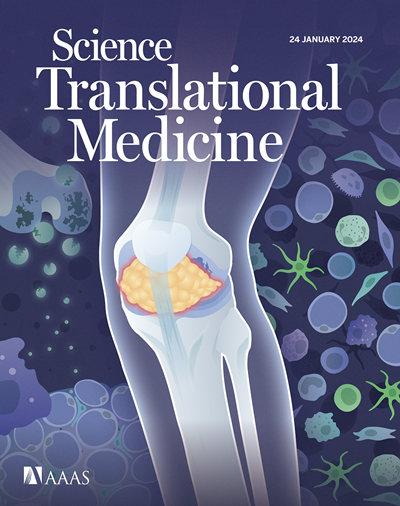自然杀伤细胞促进中性粒细胞胞外捕获,抑制小鼠黄斑变性。
IF 15.8
1区 医学
Q1 CELL BIOLOGY
引用次数: 0
摘要
新生血管性老年黄斑变性(nvAMD)是老年人失明的主要原因。尽管人们知道新生血管性老年黄斑变性与局灶性炎症有关,但对支配这一过程的精确免疫成分的了解仍然有限。在这里,我们发现自然杀伤(NK)细胞是渗入nvAMD患者和小鼠模型脉络膜新生血管(CNV)病变血管周围空间的主要淋巴细胞群。Olink蛋白组分析和单细胞RNA测序结合基因敲除研究证明,C-C趋化因子受体5(CCR5)参与了小鼠CNV部位的NK细胞招募和外渗。消耗NK细胞或抑制活化受体NK 2组D成员(NKG2D)可抑制中性粒细胞胞外捕获物的形成、增加血管渗漏并加剧病理性血管生成,这表明NK细胞抑制了该小鼠模型的发病机制。年龄是导致老年性视网膜病变的最大风险因素,而我们的研究表明,来自高龄人类供体的 NK 细胞表现出较低的细胞毒性表型。在 CNV 小鼠模型中,来自高龄小鼠的 NK 细胞表现出的保护作用也大打折扣。此外,白介素-2 复合物介导的 NK 细胞扩增改善了小鼠 CNV 的形成。总之,我们的研究强调了 NK 细胞是 nvAMD 患者的潜在治疗靶点。本文章由计算机程序翻译,如有差异,请以英文原文为准。
Natural killer cells promote neutrophil extracellular traps and restrain macular degeneration in mice
Neovascular age-related macular degeneration (nvAMD) is the leading cause of blindness in the elderly population. Although it is known that nvAMD is associated with focal inflammation, understanding of the precise immune components governing this process remains limited. Here, we identified natural killer (NK) cells as a prominent lymphocyte population infiltrating the perivascular space of choroidal neovascularization (CNV) lesions in patients with nvAMD and in mouse models. Olink proteomic analysis and single-cell RNA sequencing combined with knockout studies demonstrated the involvement of C-C chemokine receptor 5 (CCR5) in NK cell recruitment and extravasation at the CNV sites of mice. Depletion of NK cells or inhibition of activating receptor NK group 2, member D (NKG2D) inhibited the formation of neutrophil extracellular traps, increased vascular leakage, and exacerbated pathological angiogenesis, indicating that NK cells restrain pathogenesis in this mouse model. Age is the strongest risk factor for AMD, and we show that NK cells from aged human donors exhibited a less cytotoxic phenotype. NK cells from old mice exhibited compromised protective effects in the CNV mouse model. In addition, interleukin-2 complex–mediated expansion of NK cells improved CNV formation in mice. Collectively, our study highlights NK cells as a potential therapeutic target for patients with nvAMD.
求助全文
通过发布文献求助,成功后即可免费获取论文全文。
去求助
来源期刊

Science Translational Medicine
CELL BIOLOGY-MEDICINE, RESEARCH & EXPERIMENTAL
CiteScore
26.70
自引率
1.20%
发文量
309
审稿时长
1.7 months
期刊介绍:
Science Translational Medicine is an online journal that focuses on publishing research at the intersection of science, engineering, and medicine. The goal of the journal is to promote human health by providing a platform for researchers from various disciplines to communicate their latest advancements in biomedical, translational, and clinical research.
The journal aims to address the slow translation of scientific knowledge into effective treatments and health measures. It publishes articles that fill the knowledge gaps between preclinical research and medical applications, with a focus on accelerating the translation of knowledge into new ways of preventing, diagnosing, and treating human diseases.
The scope of Science Translational Medicine includes various areas such as cardiovascular disease, immunology/vaccines, metabolism/diabetes/obesity, neuroscience/neurology/psychiatry, cancer, infectious diseases, policy, behavior, bioengineering, chemical genomics/drug discovery, imaging, applied physical sciences, medical nanotechnology, drug delivery, biomarkers, gene therapy/regenerative medicine, toxicology and pharmacokinetics, data mining, cell culture, animal and human studies, medical informatics, and other interdisciplinary approaches to medicine.
The target audience of the journal includes researchers and management in academia, government, and the biotechnology and pharmaceutical industries. It is also relevant to physician scientists, regulators, policy makers, investors, business developers, and funding agencies.
 求助内容:
求助内容: 应助结果提醒方式:
应助结果提醒方式:


